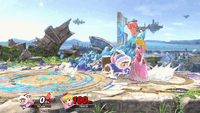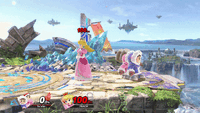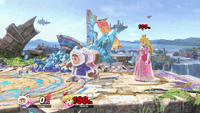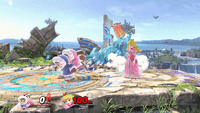| Welcome to SmashWiki! Log in or create an account and join the community, and don't forget to read this first! |
| Notices |
|---|
| The Skill parameter has been removed from Smasher infoboxes, and in its place are the new "Best historical ranking" and "Best tournament result" parameters. SmashWiki needs help adding these new parameters to Smasher infoboxes, refer to the guidelines here for what should be included in these new parameters. |
| When adding results to Smasher pages, include each tournament's entrant number in addition to the player's placement, and use the {{Trn}} template with the matching game specified. Please also fix old results on Smasher pages that do not abide to this standard. Refer to our Smasher article guidelines to see how results tables should be formatted. |
| Check out our project page for ongoing projects that SmashWiki needs help with. |
User:Yo'ster/Cheerless Smash
Cheerless smash (short for cheerless grab smash attack) refers to a desynced kill confirm combining a throw with a buffered smash attack from the partner, keeping the opponent in place to turn their otherwise weak throws into some of the strongest in the game. The damage and launch power of cheerless smashes vary depending on the player's timing, as landing the smash attack will usually interrupt the actual throw, preventing some of the throw's damage from being dealt, while delaying the smash can not only let the throw connect and damage the opponent in its entirety, but also further strengthen the combo due to charging the smash a little in the meantime.
The term comes from circumventing the partner Climber's cheer animation when the leader performs a grab and using input buffering to get the partner to perform a smash attack. Although the cheering animation was introduced in Super Smash Bros. Ultimate and certain setups have their own terms (e.g. back dash, cheer cancel, etc.), "cheerless smash" is used as a blanket term for any throw and smash attack combination that's obtained in spite of the partner's cheering.
In Super Smash Bros. Melee and Super Smash Bros. Brawl[edit]
Due to either of the duo being able to act while the other is holding an opponent in these games, throws are "cheerless" by default. As such, a cheerless smash is an unnecessary and suboptimal conversion compared to the infamous setups available. Which are noticeably easier, safer, and more rewarding. As such, cheerless smashes seldom see use in Melee or Brawl, if at all.
In Super Smash Bros. Ultimate[edit]
Primary variants[edit]
The forward-throw-forward-smash confirm, abbreviated as "FF", KOs at about 75% at its weakest, and 57% when performed optimally.
The back-throw-forward-smash confirm, abbreviated as "BF" and also known as "yeet", KOs at about 72%, and cannot be optimized due to the point from which the opponent is thrown and the lack of hitlag. The smash must be buffered, and attempting to charge it for even a single frame will cause them to swing several frames too late.
The up-throw-up-smash confirm, abbreviated as "UU", KOs at about 115% at its weakest, and 100% when performed optimally. Strangely, the up smash's knockback will be outprioritized by that of the up throw if the smash attack is buffered. Making the throw deal much more damage than it's supposed to, but without the knockback needed to KO at realistic percents. The partner Climber must charge their up smash for at least 3 frames to avoid being deprioritized. (It doesn't need to enter the charge interval, the player just has to be holding the smash-input during the 1st 3 frames of the smash's startup)
The down-throw-down-smash confirm, abbreviated as "DD", KOs at about 100% at its weakest, and 89% when performed optimally. The down smash will miss completely if it is buffered, so the partner Climber must charge their down smash for at least 10 frames to avoid swinging too early. (It doesn't need to enter the charge interval for 10 frames, the player just has to be holding the smash-input during the 1st 10 frames of the smash's startup)
Niche variants[edit]
The forward-throw-up-smash confirm, abbreviated as "FU", is usually a misinputted attempt at a UU. It KOs at about 124% at its weakest, and 122% when performed optimally. Strangely, the up smash's knockback will be outprioritized by that of the forward throw if the smash attack is buffered. Making the throw deal much more damage than it's supposed to, but without the knockback needed to KO at realistic percents. Similarly to UU, the partner Climber must charge their up smash for at least 3 frames to avoid being deprioritized. (It doesn't need to enter the charge interval, the player just has to be holding the smash-input during the 1st 3 frames of the smash's startup) As a niche and often unintentional variant, it's significantly inferior to UU, but it occasionally works as a "disrespectful" DI mixup due to the lead climber's animation making opponents anticipate an FF, and the tech's abbreviation mirroring "FU", a form of trash talk.
The forward-throw-down-smash confirm, also known as "FD", KOs at about 105% at its weakest, and 93% when performed optimally. Due to being weaker and much more difficult to perform, FD should never be used over DD.
The down-throw-forward-smash confirm, also known as "DF", KOs at about 73% at its weakest, and 59% when performed optimally. The forward smash will miss completely if it is buffered, so the partner Climber must charge their forward smash for at least 6 frames to avoid swinging too early. (It doesn't need to enter the charge interval for 6 frames, the player just has to be holding the smash-input during the 1st 6 frames of the smash's startup) Compared to DF, it can take stocks slightly sooner, but is slightly weaker when both are done perfectly.
The down-throw-up-smash confirm, also known as "DU", KOs at about 119% at its weakest, and 106% when performed optimally. The up smash will miss completely if it is buffered, so the partner Climber must charge their up smash for at least 3 frames to avoid swinging too early. (It doesn't need to enter the charge interval for 3 frames, the player just has to be holding the smash-input during the 1st 3 frames of the smash's startup) Unlike every other cheerless smash, charging the smash for a moment can actually weaken DU, as the small boost in knockback from the extra charge time is not always worth giving up the higher position from which the opponent is launched. The weakest timing is 10 frames of charge, while the minimum charge of 3 frames KOs at 115%. Due to being weaker and much more difficult to perform, DU should never be used over UU.
Trivia[edit]
- When performing a cheerless smash, the smash's knockback will sometimes be outprioritized by the throw's knockback if the player has a spirit equipped that boosts throw power.
- This is most likely due to the throw becoming stronger then the smash attack in terms of damage, and would also explain why up smash can be deprioritized if not charged slightly.





